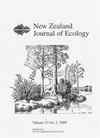1998–2016年海拔高度、播种量和控制操作对南岛Nothofagus森林鼠丰度的影响
IF 1.4
3区 环境科学与生态学
Q3 ECOLOGY
引用次数: 2
摘要
:在新西兰,船鼠(Rattus Rattus)与许多本土鸟类的灭绝、数量减少和范围缩小有关,因此船鼠是捕食者控制的重要目标。由于影响大鼠种群的其他因素,包括海拔高度、Nothofagus播种量和其他哺乳动物害虫的控制,特别是刷尾负鼠(Trichosurus vulpecula)和白鼬(Mustela erminea),船鼠控制行动的结果很难预测。在这里,我们使用了1998年至2016年来自南岛北部七个诺特霍法格斯森林的长期老鼠追踪隧道数据来解决三个问题:(1)老鼠追踪率如何随海拔高度和诺特霍法格斯播种量而变化?(2) 哪些形式的老鼠控制在降低老鼠追踪率方面更有效?(3) 有证据表明,当白鼬被诱捕控制时,中捕食者会在诺特霍法格斯森林释放老鼠吗?二项GLMM分析发现,大鼠追踪率随着海拔高度的升高而显著下降,随着诺特霍法格斯播种量的增加而增加,尤其是在2000年、2006年和2014年的高种子年。敌鼠酮,尤其是溴鼠康,并在空中应用1080,显著降低了大鼠的追踪率,而密集捕捉则没有。与早期对北岛森林的研究相反,我们发现,诱捕鼬后,老鼠的追踪率显著增加,这表明在控制鼬后,中捕食者释放了老鼠。因此,在有老鼠的Nothofagus森林中,土地管理者在决定是否在没有有效控制船鼠的情况下将白鼬困在一个区域时,应考虑白鼬和船鼠对当地野生动物的相对威胁。这项研究强调了长期数据集在识别可能未被发现的关系方面的价值。本文章由计算机程序翻译,如有差异,请以英文原文为准。
Effects of altitude, seedfall and control operations on rat abundance in South Island Nothofagus forests 1998–2016
: In New Zealand, ship rats ( Rattus rattus ) have been implicated in many extinctions, declines, and range contractions of native birds, so ship rats are an important target of predator control. The outcomes of ship rat control operations are difficult to predict due to other factors which affect rat populations including altitude, Nothofagus seedfall, and control of other mammalian pests, particularly brushtail possums ( Trichosurus vulpecula ) and stoats ( Mustela erminea ). Here we used long-term rat tracking-tunnel data 1998–2016 from seven Nothofagus forest sites in the northern South Island to address three questions: (1) How do rat tracking rates vary with altitude and Nothofagus seedfall? (2) Which forms of rat control are more effective at reducing rat tracking rates? (3) Is there evidence for mesopredator release of rats in Nothofagus forests when stoats are controlled by trapping? Analysis with binomial GLMMs found that rat tracking rates significantly declined with altitude and increased with Nothofagus seedfall, especially during high-seed years in 2000, 2006, and 2014. Diphacinone, and especially brodifacoum and aerially applied 1080, significantly reduced rat tracking rates, whereas intensive snap-trapping did not. Contrary to earlier studies from North Island forests, we found that rat tracking rates increased significantly with mustelid trapping, suggesting mesopredator release of rats following stoat control. Therefore, in Nothofagus forests where rats are present, land managers should consider the relative threats to native wildlife from stoats and ship rats when deciding whether to trap stoats in an area without effectively controlling ship rats. This study highlights the value of long-term data sets for identifying relationships that may otherwise go undetected.
求助全文
通过发布文献求助,成功后即可免费获取论文全文。
去求助
来源期刊

New Zealand Journal of Ecology
环境科学-生态学
CiteScore
3.00
自引率
12.50%
发文量
35
审稿时长
>36 weeks
期刊介绍:
The New Zealand Journal of Ecology is a biannual peer-reviewed journal publishing ecological research relevant to New Zealand/Aotearoa and the South Pacific. It has been published since 1952 (as a 1952 issue of New Zealand Science Review and as the Proceedings of the New Zealand Ecological Society until 1977). The Journal is published by the New Zealand Ecological Society (Inc.), and is covered by Current Contents/Agriculture, Biology and Environmental Science, GEOBASE, and Geo Abstracts.
 求助内容:
求助内容: 应助结果提醒方式:
应助结果提醒方式:


